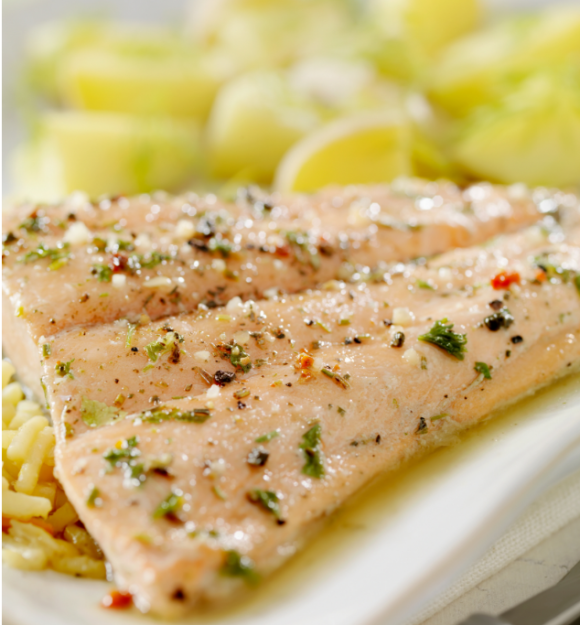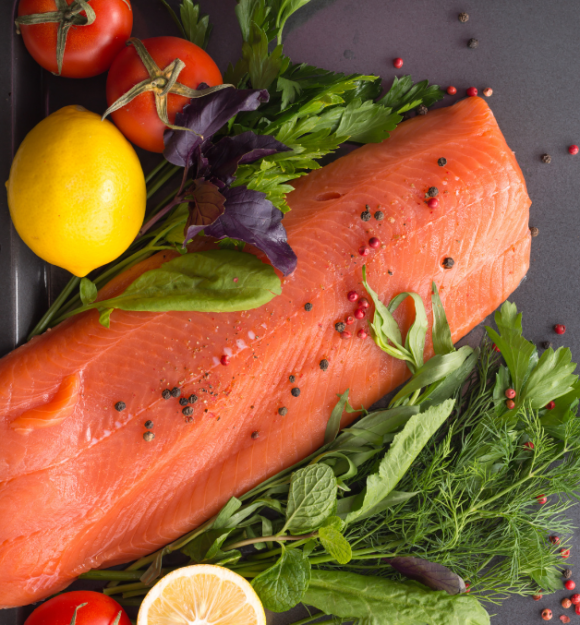Omega-3 fatty acids are one of the healthiest “fats” for your body and unfortunately, these kinds of fats can only be found in supplements or in the foods you eat. Our bodies do not produce these fats naturally as our body produces other kinds of fats it needs. These particular fats help with brain and eye development in babies and it is believed that these special fatty acids improve overall brain function in people with memory problems. These fatty acids are also known to help reduce the risk of developing certain conditions and diseases such as rheumatoid arthritis, depression, and ADHD to name a few.
Omega-3 fatty acids are one of the most common ingredients found in best-quality supplements. That’s why salmon, which is one of the richest sources of omega-3 fatty acids, is good for you especially Oshen Salmon! It supports your immune system, decreases inflammation, and provides you with good-looking, healthy skin.
Now, you might be thinking you have to cook salmon often to get these amazing fatty acids in your diet but rest assured we have a great solution for you and that is why we are suggesting dehydrating salmon for those days you are on the go and or those days you want to indulge in a healthier snack option. Dehydrating salmon is going to lock in its nutrient values, taste, and flavors, making it you’re new go-to!
How to Dehydrate Salmon
Using a dehydrator is the easiest way to cook salmon jerky. But it is possible to dehydrate salmon even without using a dehydrator.
In this post, we will learn how to dehydrate salmon with and without using a dehydrator.
Dehydrating Salmon using a Dehydrator
You can use any spices and flavorings you want, however, plan in advance because you will need roughly eight hours of marination time.
Preparation:
Make sure you use only the highest quality salmon. Obviously, we recommend BluGlacier. Only the best for your body!
Step 1: Freeze Your Salmon
Freeze the salmon for half an hour, or until it becomes slightly firm. This will make it easy to cut the salmon.
Step 2: Separate the Skin and the Flesh
Use a sharp knife and cut salmon into 1/4 inch pieces. Cut through the skin, scrape the knife against it, and peel the salmon’s skin away from the meat.
Do this until the meat is entirely separated from the skin. If you want, crisp the skin in the oven until it turns brown, also making it another delicious snack!
Step 3: Mix all Ingredients
Use a glass bowl and add your desired seasonings. Then, add salmon slices into the mixture and let it sit in the fridge for 10-12 hours. Make sure you cover it before putting it in the fridge.
Here are two suggestions of marinades you can try when dehydrating salmon.
Sesame Ginger Salmon Flavor ( recipe via Edible Communities )
Ingredients
- 1½ pounds salmon fillets
- ¼ cup sesame oil
- 2 tablespoons low sodium soy sauce
- 3 tablespoons rice vinegar
- 2 tablespoons brown sugar
- 2 cloves garlic minced
- 1 tablespoon grated fresh ginger
- 1 tablespoon sesame seeds
- ½ teaspoon ground black pepper
Cayenne Salmon Flavor ( recipe via The Spruce Eats )
Ingredients
- 1 cup salt (NOT iodized)
- 2 1/2 cups light brown sugar
- 1/4 cup soy sauce
- 1-gallon water
- Salmon fillets (skin removed)
- Cayenne pepper (optional)
Step 4: Prepare Salmon for Dehydration
Next, take out the salmon pieces of the brine and lay them on a greased baking sheet. As a result, salmon pieces will soak up the liquid dripping from the meat.
After that, carefully place each piece at least half an inch away from each other.
Step 5: Start the Dehydration Process
Shift the salmon pieces to the dehydrator racks. Turn on the dehydrator and let the slices dry at 145 degrees F for three to four hours.
Once the color of the slices turns reddish-brown, you can pull them out of the machine. To cross-check if you have done this right, bend them. The slice should not snap in half.
Once prepared, you can store these delicious crispy, dehydrated jerky pieces in jars for about 2 weeks. You get longer shelf life if you store your jerky pieces in the fridge, which can last for up to two months.
Dehydrating Salmon Without Using a Dehydrator
If you do not have a dehydrator, you can use your oven to dehydrate salmon to taste the same.
To do this, the same ingredients are required, except the process is slightly different. Here we go step by step for making salmon jerky:
Step 1: Prepare your Seasoning
Assuming you are preparing a marinade for your salmon, mix all your ingredients together in a saucepan. Now, bring the mixture to a boil and cook it until any salt and sugars are dissolved. It will take about 2-3 minutes. Remove the saucepan from heat and cool marinade.
Step 2: Prepare Your Salmon Slices
Cut your salmon into strips with or without the skin. Next, pour marinade into a bowl and lay the strips in it so that the salmon can soak up the liquid. Refrigerate it for 45-50 minutes.
Step 3: Bake It
Preheat your oven to 185 degrees F. Take a baking sheet and line it with aluminum foil. Place the sheet onto a wire rack.
Next, lay the cut salmon strips on the wire rack while discarding the extra marinade. Finally, put the sheet of salmon in the oven for nearly 8 hours, until dehydrated.
Have you tried dehydrated salmon?
Would love to know if you’ve tried it and how it was flavored! Leave us a comment to share your salmon jerky experience!



